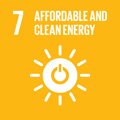- Docente: Alberto Bellini
- Credits: 6
- SSD: ING-IND/32
- Language: Italian
- Teaching Mode: Traditional lectures
- Campus: Cesena
-
Corso:
Second cycle degree programme (LM) in
Electronics and Telecommunications Engineering for Energy (cod. 8770)
Also valid for Second cycle degree programme (LM) in Electronics and Telecommunications Engineering for Energy (cod. 8770)
Learning outcomes
The student will receive operating principles and design cues for power converters, aimed at optimal efficiency. This knowledge can be used for analysis, design and control of power stage in wind farms and photovoltaics.
Course contents
Power Electronics
- Review of most common power electronic devices for static energy conversion: Diodes, MOSFET, IGBT.
- Basic Configurations of AC/DC, DC/DC, DC/AC converters
- Grid connection
AC/DC converters
- Non controlled diode rectifiers
- Controlled rectifiers
DC/DC converters
- Buck
- Boost
- Buck-boost
- Cük
Inverter
- Modulation techniques
- Single-phase architectures
- Three-phase architectures
Photovoltaics power generation
- Overview of photovoltaic energy conversion systems. Structure of a photovoltaic system. Power converters for grid connection. Maximum Power Point Technologies. Advanced photovoltaic technologies.
Wind power generation
- Overview of wind energy conversion systems. Conventional wind energy conversion systems. Power grid connection.
Tidal power generation
- Overview of tidal energy conversion systems. Structure of a photovoltaic system. Power converters for grid connection. Maximum Power Point Technologies. Advanced photovoltaic technologies.
Readings/Bibliography
Mohan Ned, Undeland Tore, Robbins William, "Power Electronics: Converters, Applications and Design", John Wiley & Sons Inc; 4 edizione
Robert W. Erickson, Dragan Maksimovic, "Fundamentals of Power Electronics", Kluwer Academic Pub
Muhammad Rashid, "Power Electronics Handbook", Butterworth-Heinemann; 4 edizione, 2017.
Remus Teodorescu, Marco Liserre, Pedro Rodríguez, "Grid Converters for Photovoltaic and Wind Power Systems", John Wiley & Sons Inc Print on
S. Chkraborty, M.G. Simoes, W.E. Kramer, "Power Electronics for Renewable and Distributed Energy Systems. A sourcebook of topologies, control and integration", Springer, 2013Teaching methods
Lectures with Power Point slides.
Numerical simulation with MATLAB
Assessment methods
Locally developed pre- and post- tests will be used to assess skills in power converters analysis and design.
Teamwork projects will be used to assess the capability of solving real problems, e.g. basic power stages for wind and photovoltaic converters.
All students will show substantial improvement in stated learning outcomes, as indicated by pre- and post- evaluation of real problems.
Teaching tools
Lectures with Power Point.
Teamwork and numerical simulation of basic power converter topologies.
Office hours
See the website of Alberto Bellini
SDGs

This teaching activity contributes to the achievement of the Sustainable Development Goals of the UN 2030 Agenda.
